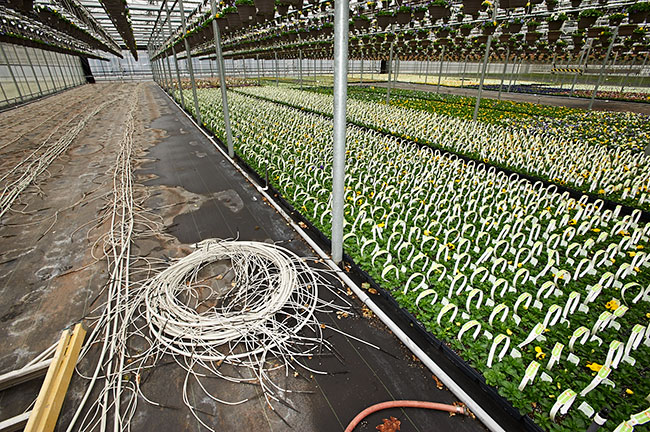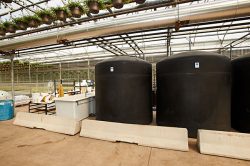
Features
Water and irrigation
Finding water sanitation problems before they start
It may be a tired saying, but prevention really is worth a pound of cure (or fungicide) when it comes to heading off disease issues.
June 16, 2020 By Dr. Chevonne Dayboll and Dr. Sarah Jandricic
 Ensure that irrigation lines are cleaned
before new crops go in. All images: OMAFRA
Ensure that irrigation lines are cleaned
before new crops go in. All images: OMAFRA This is part 1 of the water sanitation series.
Ever wonder how water-related disease issues just seem to pop up out of nowhere? You’ve never had a problem before, but suddenly things just aren’t looking right.
The truth is that problems often go unnoticed while pathogen levels are low. Or, problems can suddenly appear if a new pathogen is brought in through a variety of routes. Knowing potential inoculum sources and practising good preventative measures can help to reduce the risk of a big problem down the road.
Your irrigation water can be a potential source of inoculum. In your own operation, you might rely on rainwater, well water or city water. Your water sources might vary based on their purpose in the greenhouse: for use on the potting line or production irrigation, for example. The source might also change throughout the year, depending on your production needs and the availability of any given source.
Knowing the quality of all your water sources is a must for avoiding problems. The cost of a regular water test may be worth it if you can avoid costly applications of corrective products over the season. Aim to take, at minimum, seasonal samples of your water to ensure that it is free from contaminates. Knowing the attributes of your irrigation water can also help you to tailor your fertigation program – a win-win!
Your water storage method should also be considered. If you rely on rainwater, you might collect if off the greenhouse roof and store it in cisterns for later use. When was the last time you cleaned your cistern? It’s certainly not an easy job, but it’s a preventative measure that could save you a lot of hassle in the long run. This is most easily done during slower production times. But, it should be a yearly priority to avoid future problems, as many pathogens can accumulate in the biofilm that lives in tanks.
Next, think about how water travels around your greenhouse. Do you use overhead irrigation booms, flood floors or spaghetti lines with drippers? When was the last time they were cleaned? Clogged drippers and low irrigation output can be a clue that biofilm is lurking in the lines. You might also notice film on pots that are sub-irrigated. Make sure that cleaning lines, floors and boom nozzles is a part of your seasonal sanitation routine. Making the effort to clean your cistern doesn’t really make sense if you’re not going to follow it up with clean irrigation lines, too.
Map the path of water through your greenhouse. If you end up with a problem, this is a resource that can really help to narrow down the source. Think about all water sources and where they go to in the greenhouse.
For example: Farm A has two cisterns, one feeds propagation ranges and the second feeds the rest of production. The production cistern pumps water to zones in order of their distance from it. The potting line is not connected to either cistern, and the water source varies based on the season and crop. During finishing of their main crop, the grower switches to overhead hand watering, using water pulled from the propagation cistern.
A list of what water is used where (like the one prepared for Farm A) can really help when you are faced with a problem. Another good idea is to map this flow out, indicating any changes as you move through a production season. See this example from Farm B pictured above, which shows how recirculating water is treated and stored, and how rain water (also called stormwater) is a source of water for production in the greenhouse and outside in the summer months.
By starting off with an understanding of how your water flows through your greenhouse, along with clean water storage and irrigation lines, you’ll be better equipped to understand and tackle disease problems – and their sources – if they should arise.
Learn more
This article is the first in a series from ONfloriculture.com about water sanitation. The series is meant to get you reflecting on your own irrigation system before you are faced with a problem.
Posts throughout the season will focus on identifying problems in the greenhouse, pathogen transmission by water, interpreting lab test results, on-farm methods for disease monitoring, water treatment technology options and more. These resources will be a great source of information and a good refresher for all growers. Make sure to subscribe to the blog so you can follow each post as they are published!
Stay tuned for the next entry in this series on ONfloriculture.com: “Which pathogens are really in your water?”.
Chevonne Dayboll, PhD, is the greenhouse floriculture specialist and Sarah Jandricic, PhD, is the greenhouse floriculture IPM specialist for the Ontario Ministry of Agriculture, Food and Rural Affairs. They can be reached at chevonne.dayboll@ontario.ca and sarah.jandricic@ontario.ca.
Print this page

